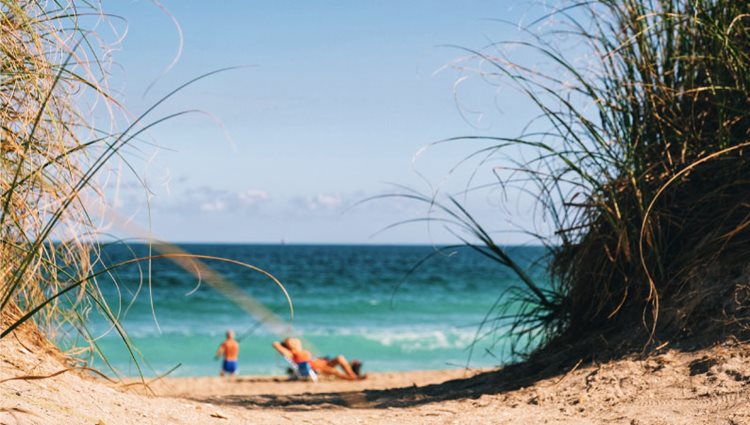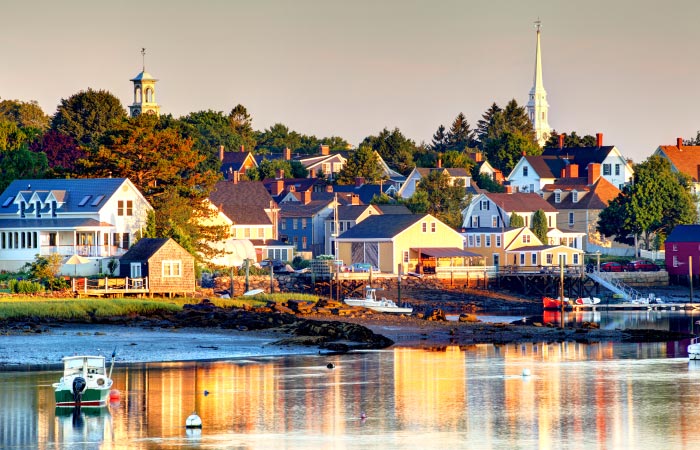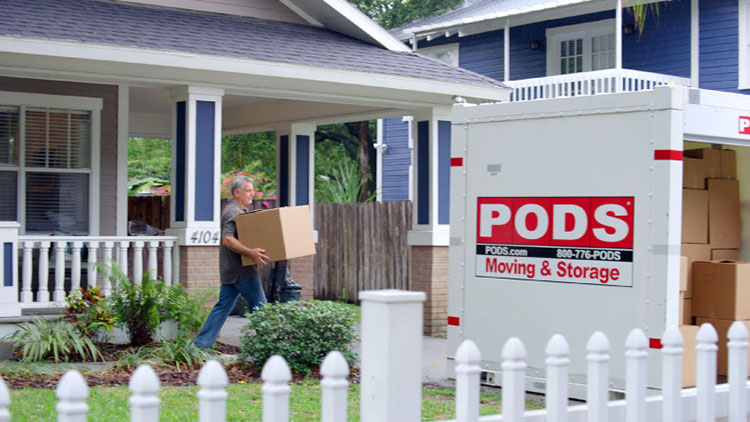
Top 10 Best States To Retire In: 2025 Edition
Retirement
Retirement evokes images of the sweet life — sipping coffee on the veranda, enjoying long lunches with friends, going to see a movie whenever you feel like it, or inviting neighbors over for a margarita to watch the sunset from your beach house. But where is that beach house exactly? And can you enjoy that veranda year-round? To find your answers, you’ll have to explore the best states to retire.
| Planning a move? Start by getting a quote from PODS. |
But as you think about shifting from work to play, you may be wondering what states rank as the best retirement states. It’s only natural — this is an important time in your life you’ve fantasized about for years. You want to get it right. Now is an ideal time to start planning your retirement, and part of that process may be choosing to relocate to a state where the weather meets your needs, and the costs for housing, recreational activities, healthcare, and other necessities fit into your overall retirement budget.

If you’re looking for the best states to retire, start your search in Florida, Minnesota, and Colorado.
What Are the 10 Best States To Retire in 2025?
If you’re ready to enjoy that sweet retiree life and you want to get a move on, here are the best states for retirement, according to WalletHub.*
1. Florida
2. Minnesota
3. Colorado
4. Wyoming
5. South Dakota
6. Pennsylvania
7. New Hampshire
8. Delaware
9. North Dakota
10. Wisconsin
*WalletHub compared data from all 50 states and evaluated each state considering 46 factors, including financial concerns like cost of living and tax-friendliness, as well as living conditions such as weather, access to care, how much of the population is 65+, and bingo halls per capita.
We’re going to take a deeper look at each of these top 10 states to retire in, delving into specifics like cost of living, things to do, and tax-friendliness to suss out everything from the best states to retire with a pension to the cheapest state to retire. So, what are the best states to retire in? Read on to find out.
Top 10 States To Retire in 2025
As important as they are, tax rates aren’t the only thing to consider when finding the right state to retire in. Let’s dive into our list of the top 10 states to retire in 2025 and see exactly why these states are so great for retirees.

Looking for the best place to retire in Florida? Check out Rio, Highland Beach, and Siesta Key.
1. Florida: The Tax-Friendly Titan
- Average home value: $387,500
- Average rent (one-bedroom): $1,975
- State income tax: No state income tax
- Cost of living: 103.1
- Population 65+ years: 21.7%
Looking for the number one state to retire in? Florida leads our list of best states to retire, as it’s one of the most affordable places for retirees. Why? Florida is a “very tax-friendly state” with no state income tax and no tax on pension income — which is great for people who want to enjoy their retirement fund to its fullest potential. The cost of living is 3.1 percent more than the national average, but the state doesn’t have estate or inheritance taxes either, another plus when thinking about the best states to retire for taxes.
Florida has a thriving senior community with plenty of recreation for retirees, including fantastic beaches, beautiful natural attractions like freshwater springs, and some of the best golf courses in the country. If you’re sold on the state but are still wondering about the best place to retire in Florida, consider Rio, Highland Beach, and Siesta Key, which are the top three spots according to Niche.
However, you also have to consider its weather and climate. Florida is known as The Sunshine State and, while it does offer warmer winter temps than most other parts of the country, it also experiences hot, humid summers as well as tropical storms, hurricanes, and tornadoes.
2. Minnesota: The Healthcare Hero
- Average home value: $337,900
- Average rent (one-bedroom): $1,600
- State income tax: 5.35%–9.85%
- Cost of living: 97.2
- Population 65+ years: 17.8%
Retiring in Minnesota means having unparalleled access to good healthcare: A big part of the reason for its second-place ranking is because it comes in first place in the healthcare facilities per capita category. It also placed second in the most nursing homes, third in having health aids, the fifth-best geriatric hospitals in the nation, and the third-lowest percentage of seniors with a disability.
It’s also not hard to live affordably in Minnesota, thanks to its below-average cost of living, which includes lower costs when it comes to groceries, healthcare, utilities, and transportation. Housing is slightly above average, though pretty affordable compared to many other states — the average home value is just below $338,000.
Some of the best places to retire in Minnesota, according to Niche, are Edina, Mendota Heights, and North Oaks. Wherever you live, though, be sure to travel around the state to visit sites of interest like the Minneapolis Institute of Art, the Mall of America, and Gooseberry Falls State Park, just to name a few of the incredibly diverse things to do around the state.
3. Colorado: The Outdoor Lover’s Oasis
- Average home value: $551,900
- Average rent (one-bedroom): $1,850
- State income tax: 4.25%
- Cost of living: 120.5
- Population 65+ years: 16%
If the Florida heat isn’t for you, Colorado’s dry climate might just be. Those hoping to fill their Golden Years with lots of physical activity will thrive here, thanks to the forgiving weather and surplus of stunning mountains, parks, and trails. According to WalletHub, colorful Colorado ranks exceptionally high for the proportion of seniors who are in good health and have a physically active lifestyle. The state also has one of the lowest rates of social isolation among seniors.
Not to mention, there are no estate or inheritance taxes in Colorado, making it easier to transfer your property or wealth to loved ones later in life. Unsure which Colorado city to hone in on? Check out Denver — two of the three best places to retire in Colorado (Columbine Valley first, Holly Hills third) are in the state’s capital, according to Niche.
Wyoming isn’t just one of the best states to retire — it’s one of the most beautiful states in the U.S. From Yellowstone to Grand Teton, be sure to check out its national parks.
4. Wyoming: The Stunning Showstopper
- Average home value: $357,700
- Average rent (one-bedroom): $1,325
- State income tax: No state income tax
- Cost of living: 97.5
- Population 65+ years: 19.2%
Not only do Wyoming residents enjoy a cost of living 2.5 percent below the national average index, but they pay a smaller proportion of their income toward taxes than they would in most other states. Notably, it’s one of the nine states with no state income tax.
It also doesn’t hurt that Wyoming’s natural scenery is stunning. It’s no wonder the World Population Review dubbed it the eighth most beautiful state in the U.S. You’ve most definitely heard of Yellowstone National Park, which attracts droves of visitors every year with its unbelievable geysers, hot springs, majestic canyons, and abundant wildlife. But there are so many other natural beauties to see in Wyoming, too, from Grand Teton National Park to Red Canyon.
As for the best places to retire in Wyoming, Niche recommends Thermopolis (the Wyoming city with the fourth-lowest cost of living), Ranchettes (also ranked the ninth best place to live overall in Wyoming), and Worland (ranked the third-lowest cost of living in Wyoming).
5. South Dakota: The Financially Friendly Frontier
- Average home value: $308,800
- Average rent (one-bedroom): $1,175
- State income tax: No state income tax
- Cost of living: 89.3
- Population 65+ years: 18.4%
Retiring in South Dakota means enjoying financial benefits that make life easier for seniors. The state has no income tax, which means Social Security, pensions, and retirement account withdrawals remain untaxed. It also boasts one of the lowest overall tax burdens in the nation, allowing retirees to stretch their savings further. Additionally, South Dakota has a low cost of living and affordable housing (median home values sit just above $310,000, well below the national average).
South Dakota also offers a peaceful, scenic lifestyle with plenty of outdoor recreation. The Black Hills, Badlands National Park, and Custer State Park provide stunning landscapes for hiking, fishing, and wildlife watching. For those who prefer small-town charm or vibrant communities, cities like Milbank, Hot Springs, and Mobridge rank among the best places to retire according to Niche.
Beyond affordability and natural beauty, South Dakota fosters a strong sense of community with its friendly residents and numerous local events. Whether exploring historic Deadwood, visiting Mount Rushmore, or enjoying the annual Sturgis Motorcycle Rally, retirees will never run out of things to do in this welcoming state.
6. Pennsylvania: The Low-Cost Locale
- Average home value: $272,300
- Average rent (one-bedroom): $1,750
- State income tax: 3.07%
- Cost of living: 94.6
- Population 65+ years: 20%
Is PA a good place to retire? We’ll let the facts speak for themselves. Not only is Pennsylvania one of the states that don’t tax retirement income, but it also has a cost of living below the national average, affordable housing, and a relatively low state income tax rate compared to other states in the Northeast. Safe to say Pennsylvania is a contender for one of the best states to retire in.
History buffs will delight in Pennsylvania’s many historic sites and buildings dating back to the 17th and 18th centuries. If you’re more of a nature lover, there are 86,000 miles of rivers and streams, over 6,700 miles of trails, 22 ski resorts, and 124 free state parks, where you can hike, bike, and ski to your heart’s content. And if you’ve even wanted to explore the Appalachian Trail, that’s here, too!
Additionally, Pennsylvania’s cities are home to world-class museums, art, dining, breweries, and more pro sports teams than you can shake a stick at. Moving to Philadelphia or Pittsburgh, in particular, will provide plenty of opportunities for big-city living, if that’s what you’re looking for.
It’s important to note, though, that Pennsylvania experiences harsh winters with lots of snow, and the state is known for having bad traffic, in general — both reasons why driving here can be difficult. There are also additional taxes to consider. For instance, municipalities and school districts can impose an additional tax on residents, called a local Earned Income Tax (EIT).
Some of the best places to retire in Pennsylvania are Harrisburg, Reading, and Lancaster.

Not only is New Hampshire one of the best retirement states, it’s also one of the safest states to live.
7. New Hampshire: The Safe Spot
- Average home value: $487,500
- Average rent (one-bedroom): $2,150
- State income tax: No state income tax
- Cost of living: 105.8
- Population 65+ years: 20.8%
If you decide to retire in New Hampshire, you’re in good company. More than one-fifth of the population is over the age of 65, after all, and it’s only growing. What does retiring here look like, though? Think: Driving to charming Portsmouth for boutique shopping and a bite to eat, enjoying the natural beauty of the White Mountains and the 18 miles of Atlantic Ocean coastline, and an easy drive for day trips to local spots as well as nearby cities like Boston. The Granite State may be small, but it is certainly mighty.
New Hampshire also enjoys the huge benefit of having no state income tax and no sales tax! However, it’s worth noting that it does have some of the highest property taxes in the country, and the cost of living is almost six percent above the national average. Retirees can rest easy, though, knowing that it also has one of the lowest crime rates in the country.
When you’re looking for which town to settle down in, check out our guide to the best places to retire in New Hampshire.
8. Delaware: The Character-Filled Charmer
- Average home value: $390,000
- Average rent (one-bedroom): $1,675
- State income tax: 2.2%-6.6%
- Cost of living: 103.5
- Population 65+ years: 21.3%
Delaware may be small, but it’s got a lot of character. This northeast coastal state is chock full of charming little towns with plenty to keep you busy in your retirement. From Atlantic Coast towns like Rehoboth Beach to quiet, suburban Greenville, you’ll find what you’re looking for in Delaware. Not to mention, the state’s close proximity to other large metropolises (Baltimore; Washington, DC; and Philadelphia, to name a few).
While the cost of living is a bit higher in Delaware than the national average, the state income tax is relatively low, and there’s no state or local sales tax. Residents also enjoy solid access to healthcare and a lower risk of social isolation.
If you enjoy cozying up to a fire in the winter, you’ll have plenty of opportunities with Delaware’s long, snowy winters. And don’t worry if the cold isn’t your thing; the spring and autumn months in Delaware are gorgeous, and the summers are mild.
If Delaware sounds like the place for you, start your search with Dover, Milton, and Wilmington — three of the best places to retire in Delaware.
9. North Dakota: The Affordable Adventure
- Average home value: $269,500
- Average rent (one-bedroom): $1,125
- State income tax: 1.95%–2.5%
- Cost of living: 88.6
- Population 65+ years: 17%
Want low financial pressure and a high quality of life? If you’re ok with a little cold weather, then North Dakota might be the perfect spot for your retirement. The state has no income tax on Social Security benefits and offers low property taxes, making it an affordable choice for retirees. Additionally, North Dakota has one of the lowest costs of living in the nation, with housing prices well below the national average — the median home value is just over $265,000, allowing retirees to get more for their money.
North Dakota also provides excellent healthcare access, ranking highly for quality hospitals and medical facilities per capita. If you’re wondering where to plant your roots, Niche ranks Valley City, Jamestown, and Rugby as the top three places to retire in the state. And these cities are also in the top 10 places in North Dakota with the lowest cost of living.
Outdoor enthusiasts will love North Dakota’s wide-open spaces and scenic beauty. From the rugged Badlands to the peaceful shores of Lake Sakakawea, the state offers endless opportunities for fishing, hiking, and wildlife watching. Cultural attractions, like the North Dakota Heritage Center, Theodore Roosevelt National Park, and Fargo’s vibrant downtown, provide plenty of entertainment. With its affordability, safety, and natural charm, North Dakota is a hidden gem for retirement.
10. Wisconsin: The Cost-Effective Community
- Average home value: $312,200
- Average rent (one-bedroom): $1,325
- State income tax: 3.5%–7.65%
- Cost of living: 89.9
- Population 65+ years: 19.1%
Retiring in Wisconsin means enjoying a perfect blend of affordability, natural beauty, and vibrant communities. The state’s cost of living is below the national average, with housing prices that are especially reasonable (the median home value sits around $300,000, making it an attractive option for retirees). Wisconsin also offers tax-friendly policies for seniors, including no taxation on Social Security benefits and exemptions for portions of retirement income, helping stretch savings further. Elm Grove, a suburb of Milwaukee, is ranked by Niche as the best place in Wisconsin to retire, followed by Allouez and Mequon (another Milwaukee suburb).
Another benefit of retiring in Wisconsin is that the state doesn’t have a set retirement age — you can retire whenever you’re financially and emotionally ready. However, Social Security, which you can begin receiving at 62, increases if you wait until age 66–67. Also, Medicare begins at 65, so if you’re retiring early, you may need to set up another source of health coverage.
Wisconsin is a haven for outdoor lovers, with four distinct seasons and endless recreational opportunities. From the scenic shores of Lake Michigan to the Northwoods’ pristine forests and lakes, retirees can enjoy hiking, fishing, boating, and winter sports. Whether exploring the Harley-Davidson Museum, savoring cheese and craft beer, or cruising the Great River Road, retirees in Wisconsin will never run out of things to enjoy.
Thanks to its relative affordability and high quality of life for seniors, sunny Florida takes the No. 1 spot on our list of the best states to retire in 2025.
5 of the Best States To Retire With a Mild Climate
You may have noticed that most of the states on our list of 10 best states to retire in 2025 aren’t necessarily “warm” places to live. And while living in a sunny state isn’t for everyone, we know there are still plenty of retirees looking for a hot spot to land. So these are the 5 best states for retirement with mild weather, along with their overall rankings on the Wallethub list:
1. Florida (Number one state to retire in overall)
2. Virginia (11th overall)
3. North Carolina (12th overall)
4.South Carolina (20th overall)
5. California (21st overall)
Other Popular Contenders for the Best States To Retire
There are as many opinions on places to retire as there are on retirement itself — especially in a country as large and diverse as the United States. For example, Empower ranked Alaska and New Hampshire as the best states to retire in 2025, followed by New Hampshire, Delaware, Pennsylvania, and Oregon. Why Alaska and New Hampshire? Empower’s methodology took into account the states with the highest percentage of millionaires, then compared that list with the states that have the lowest taxes to see which states make both lists. They felt this process accounted for both lifestyle considerations and financial advantages.
Those Are the Best States To Retire — But What About the Worst?
Kentucky
Though Kentucky has a below-average cost of living, it has a flat rate state income tax of 4 percent and ranks low in WalletHub’s evaluations of quality of life and healthcare.
Louisiana
Louisiana may be an affordable state, but it also has a high poverty rate among seniors, and below-average healthcare quality.
Mississippi
Mississippi has a low cost of living, but older residents have a high risk of social isolation.
Washington
It’s a state filled with natural beauty, but some retirees decide against calling Washington home because of its high cost of living and estate tax.
New Mexico
It’s a unique state filled with natural charm, but New Mexico also boasts a high crime rate and isn’t as tax-friendly as other options on this list.

Unsurprisingly, the best state to retire in 2025 is sunny Florida.
Best States To Retire in 2025 — FAQs
Q: What Is the Best State To Retire in 2025 for Retirees?
A: The best state to retire in 2025 is sunny Florida, thanks to its relative affordability and high quality of life for seniors. That’s followed up by Minnesota, Colorado, and Wyoming.
Q: What State Has the Lowest Cost of Living for Retirees?
A: Alabama ranks as the most affordable state to retire in. The southern state boasts a cost of living nearly 16 percent below the U.S. average, with particularly low costs for housing, transportation, and groceries.
Q: What Is the Best State To Retire To Avoid Taxes?
A: According to SmartAsset, seven states are “Very Tax Friendly” for retirees. These states have friendly property, sales, estate, and inheritance tax rates. They also have either no state income tax, no retirement income tax, or a substantial tax deduction on retirement income.
1. Alaska*
2. Florida*
3. Georgia
4. Mississippi
5. Nevada*
6. South Dakota*
7. Wyoming*
*No state income tax
Q: What Are the States That Don't Tax Retirement Income?
A: Every state has its own approach when it comes to taxing retirement income. For example, Florida, Texas, Nevada, Wyoming, and South Dakota don’t have any income tax, while Pennsylvania, Illinois, and Mississippi do have an income tax but exempt most or all retirement income from taxation. Some states, like New York and Colorado, offer partial exemptions.
Q: What States Don’t Tax Social Security for Retirees?
A: This one’s big for retirees when it comes to where to retire. Most states — plus the District of Columbia — do not tax Social Security benefits. And the 15 states listed below don’t tax pension income, making them among the best states to retire with a pension:
1. Alabama
2. Alaska*
3. Florida*
4. Hawaii
5. Illinois
6. Iowa
7. Mississippi
8. Nevada*
9. New Hampshire*
10. Pennsylvania
11. South Dakota*
12. Tennessee*
13. Texas*
14. Washington*
15. Wyoming*
*No state income tax. Note that New Hampshire does have a 4 percent tax rate on investment income (dividends and interest earned), although it's being phased out and will be completely repealed in 2025.
Q: What States Don’t Tax Your 401(k) When You Retire?
A: Retirement distributions from 401(k) plans are considered taxable income. However, these states don’t have an income tax:
1. Alaska
2. Florida
3. Nevada
4. South Dakota
5. West Virginia
5. Tennessee
6. Texas
7. Washington
8. Wyoming
In addition to the eight states above that don’t have an income tax at all, four states do not tax retirement income:
1. Illinois
2. Iowa
3. Mississippi
4. Pennsylvania
Q: What state is financially best to retire in?
A: Wondering what's the best state to retire in, money-wise? “Cost of living” is used to determine the affordability of a region. It takes into account health care, groceries and food, housing, transportation, etc. Now, there’s a lot to consider when choosing your retirement state — from weather and quality of life to taxes and cost of living. But if we’re looking at affordability alone, these states rank as the best for retirement, according to WalletHub, with Alabama topping the list as the best state to retire in financially.
1. Alabama
2.Oklahoma
3. West Virginia
4. Arkansas
5. Mississippi
Q: What is the cheapest state to live in when you retire?
A: If you’re looking for the best bang for your buck in retirement, consider Alabama. It’s one of the best states to retire in when it comes to affordability. In fact, per WalletHub, it’s ranked as the cheapest state to retire, thanks to its cost of living nearly 16 percent below the U.S. average, whereas housing is nearly 45 percent lower than the U.S. average: The average home value in Alabama currently sits around $228,700 while average rent for a one-bedroom is about $1,300.
Q: What is the best state to retire in, according to the U.S. News & World Report?
A: According to the U.S. News and World Report, as of 2025, the best state to retire in is Florida, based on the fact that Florida cities hold three spots on their top ten best places to retire list. Just like our Best States to Retire list, Florida holds the top spot.

Now that you have an idea of the best states to retire, let PODS help you make the move.
Move to One of the Best States To Retire With PODS
While affordability and tax burden are sensible things to consider when choosing a retirement destination, there are always other factors to consider, such as where your children and grandkids are living, and whether you want to become a “snowbird” and travel to Georgia or Florida for the colder months. Just something to think about!
Regardless of where you choose to retire, you’ll need to decide how to get there. If the days of doing it all yourself are behind you, consider a flexible move with PODS Moving & Storage. Have a portable moving container delivered straight to your driveway for convenient loading. If you need help with the heavy lifting, PODS can refer you to local packing and loading help. Once everything is loaded and ready to roll, your container will be picked up and transported to your new home in one of the best states to retire!
| Check out more of the PODS Blog for everything moving and storage — from packing tips and retirement to decluttering and downsizing, we’ve got you covered. |
Sofia Rivera is a Brooklyn-based lifestyle editor and frequent contributor to the PODS Blog. Her work has appeared in Boston magazine, Apartment Therapy, and more. You can most often find her redecorating her apartment, trying out a new recipe, or trekking all over the city.
Editor’s note: Average and median rent prices were obtained from RentCafe; average home values were obtained from Zillow. For ease of reading, monthly rental prices were rounded to the nearest $25 and home values were rounded to the nearest $100.
Related Articles
Comments
Leave a Comment
Your email address will not be published. Required fields are marked *


